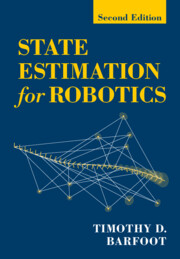State Estimation for Robotics
Second Edition
2nd Edition
$89.99 (P)
- Author: Timothy D. Barfoot, University of Toronto
- Date Published: February 2024
- availability: Available
- format: Hardback
- isbn: 9781009299893
$
89.99
(P)
Hardback
Other available formats:
eBook
Looking for an examination copy?
This title is not currently available for examination. However, if you are interested in the title for your course we can consider offering an examination copy. To register your interest please contact [email protected] providing details of the course you are teaching.
-
A key aspect of robotics today is estimating the state (e.g., position and orientation) of a robot, based on noisy sensor data. This book targets students and practitioners of robotics by presenting classical state estimation methods (e.g., the Kalman filter) but also important modern topics such as batch estimation, Bayes filter, sigmapoint and particle filters, robust estimation for outlier rejection, and continuous-time trajectory estimation and its connection to Gaussian-process regression. Since most robots operate in a three-dimensional world, common sensor models (e.g., camera, laser rangefinder) are provided followed by practical advice on how to carry out state estimation for rotational state variables. The book covers robotic applications such as point-cloud alignment, pose-graph relaxation, bundle adjustment, and simultaneous localization and mapping. Highlights of this expanded second edition include a new chapter on variational inference, a new section on inertial navigation, more introductory material on probability, and a primer on matrix calculus.
Read more- Covers both classical and modern state estimation techniques commonly used in robotics today
- Provides an accessible explanation of the mathematical nature of rotational (and pose) state variables
- Applies state estimation methods to practical robotics problems
Reviews & endorsements
‘This book provides a timely, concise, and well-scoped introduction to state estimation for robotics. It complements existing textbooks by giving a balanced presentation of estimation theoretic and geometric tools and discusses how these tools can be used to solve common estimation problems arising in robotics. It also strikes an excellent balance between theory and motivating examples.' Luca Carlone, IEEE Control Systems Magazine
Customer reviews
Not yet reviewed
Be the first to review
Review was not posted due to profanity
×Product details
- Edition: 2nd Edition
- Date Published: February 2024
- format: Hardback
- isbn: 9781009299893
- length: 530 pages
- dimensions: 260 x 185 x 35 mm
- weight: 1.174kg
- availability: Available
Table of Contents
Acronyms and abbreviations
Notation
Foreword to first edition
Foreword to second edition
1. Introduction
Part I. Estimation Machinery:
2. Primer on probability theory
3. Linear-Gaussian estimation
4. Nonlinear non-Gaussian estimation
5. Handling nonidealities in estimation
6. Variational inference
Part II. Three-Dimensional Machinery:
7. Primer on three-dimensional geometry
8. Matrix lie groups
Part III. Applications:
9. Pose estimation problems
10. Pose-and-point estimation problems
11. Continuous-time estimation
Appendix A: matrix primer
Appendix B: rotation and pose extras
Appendix C: miscellaneous extras
Appendix D: solutions to exercises
References
Index.
Sorry, this resource is locked
Please register or sign in to request access. If you are having problems accessing these resources please email [email protected]
Register Sign in» Proceed
You are now leaving the Cambridge University Press website. Your eBook purchase and download will be completed by our partner www.ebooks.com. Please see the permission section of the www.ebooks.com catalogue page for details of the print & copy limits on our eBooks.
Continue ×Are you sure you want to delete your account?
This cannot be undone.
Thank you for your feedback which will help us improve our service.
If you requested a response, we will make sure to get back to you shortly.
×

